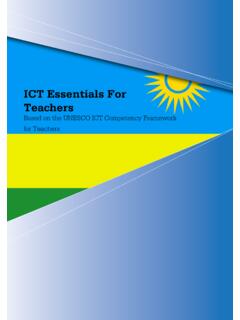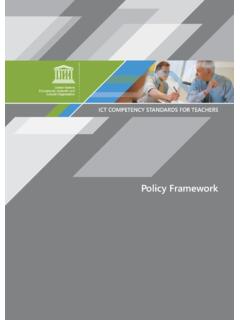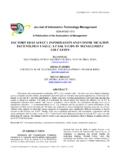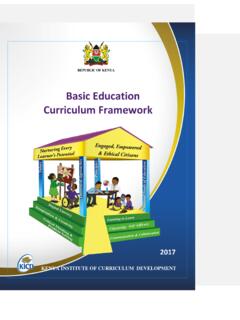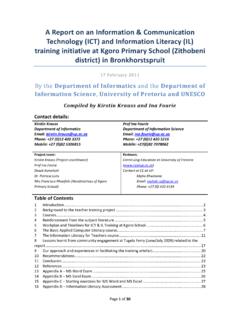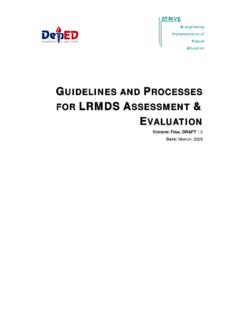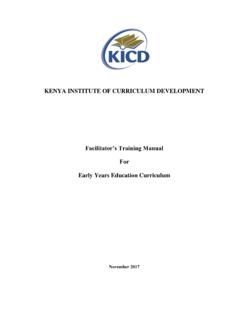Transcription of PISA 2021 ICT Framework - OECD
1 1 PISA 2021 ICT Framework OECD 2018 Table of contents 1. Introduction .. 3 Why develop a Framework to assess the integration of information and communication technologies in teaching and learning? .. 3 Objectives of the PISA 2021 ICT Framework .. 4 2. Overall conceptual Framework guiding the assessment of students interaction with ICT in PISA 2021 .. 6 Overall Framework .. 6 Relationship between access to and use of ICT resources .. 8 ICT use in the 9 ICT use outside the classroom .. 11 3. Country- and system-level factors related to access and use of ICT resources .. 14 Contextual factors affecting the overall availability of ICT resources.
2 15 Overall access to ICT resources .. 15 Access to ICT resources for learning .. 16 Policy environment governing ICT access and use in education .. 17 The regulatory Framework regarding the quantity and quality of ICT resources in schools 17 Policies and guidelines framing the use of ICT resources by students and teachers in school18 4. Access to ICT resources .. 19 Availability of ICT resources .. 21 General ICT resources .. 21 ICT resources designed for learning .. 21 Accessibility of ICT resources .. 22 Ownership and congestion .. 23 Regulations and norms .. 23 Quality of ICT resources .. 24 Functionality and maintenance of ICT resources.
3 24 Overall level of connectivity .. 25 Subjective assessment of shortages and obstacles limiting ICT use .. 25 5. The use of ICT in and outside the classroom .. 27 Students use of ICT in the classroom .. 27 Teachers use of ICT for teaching .. 28 Students use of ICT for learning in the classroom .. 29 Enabling environments for teaching and learning with ICT .. 32 Students use of ICT outside the classroom .. 34 Using ICT for learning .. 35 2 PISA 2021 ICT Framework OECD 2018 Using ICT for leisure .. 36 The environment for ICT use outside the 37 6. Students cognitive and well-being outcomes .. 39 Students cognitive achievement and well-being.
4 39 Assessing mathematical literacy in PISA .. 39 Assessing reading literacy in PISA .. 41 Assessing science literacy in PISA .. 42 Assessing adolescents well-being in PISA .. 42 Students competencies in ICT: Digital literacy, and attitudes and dispositions towards ICT .. 44 Students digital literacy .. 44 Students attitudes and dispositions towards ICT .. 48 References .. 51 Notes .. 58 Figures Figure PISA 2021 ICT conceptual Framework .. Error! Bookmark not defined. Figure Detailing ICT use in school .. 11 Figure Detailing ICT use outside the classroom .. 13 Figure Fixed broadband subscriptions per 100 inhabitants, 2017.
5 14 3 PISA 2021 ICT Framework OECD 2018 1. Introduction Why develop a Framework to assess the integration of information and communication technologies in teaching and learning? 1. Information and communication technologies (ICT) play an increasingly important role in virtually all aspects of our daily lives. Not only is technology profoundly transforming people s work and professional life, but it is also altering how people interact, communicate, retrieve and share information, and even how governments provide public services to citizens. ICT also significantly affect multiple facets of education. They can provide new opportunities for students to learn outside of school, and can change teachers pedagogical approaches and the learning experience of students in school.
6 Moreover, education systems are increasingly embedding digital competencies in their curricula. 2. ICT are integrated into schools and learning in three major ways: Students engagement with ICT (both in and outside of school) can affect their cognitive processes and their well-being, and eventually what they learn. Teachers are increasingly using ICT for instruction, and administrative and communication purposes, with numerous implications for classroom management, instructional practices, pedagogical approaches and time use. Competence in using ICT and digital literacy are being recognised as important skills that students need to acquire if they are to flourish in the digital age.
7 3. The increasing importance of digital technologies in education systems and the pressing need to equip students with digital competencies raise major policy concerns for governments: To what extent should students use ICT in and outside of school, and how should they engage with these technologies? Are ICT used for learning, for social networking or for entertainment? How and to what extent do teachers of different kinds use ICT and for what objectives? What role do ICT play in different types of pedagogical and instructional practices? Which practices work best with ICT? What are the implications of the different types of ICT use for students proficiency in mathematics, reading and science?
8 Do certain types of ICT use affect students well-being? What should governments do to ensure that young people today and tomorrow are sufficiently skilled in the use of ICT to flourish in this digital century? 4. Despite the growing body of literature focusing on the relationships between students engagement with ICT and education outcomes, there is no consensus on the contribution ICTs make to students educational attainment or cognitive performance in general. Although there is little doubt that coming generations are more likely to have the ability to engage with the latest ICT, one should not take for granted that everyone will have access to ICT resources, or that they will use ICT in ways that are responsible and beneficial to them ( that contribute to their personal development and well-being) and to society.
9 5. Moreover, although some studies have documented students access to and use of ICT resources at home and in school across countries ( Fraillon, Schulz and Ainley, 4 PISA 2021 ICT Framework OECD 2018 2013), much remains to be investigated regarding the influence of ICT availability, quality and use on students academic, and social and emotional outcomes. 6. This Framework explores these questions in the context of the Programme for International Student Assessment (PISA). In all previous rounds, starting in 2000, PISA documented various dimensions of access to and use of ICT by 15-year-old students in and outside of school.
10 For example, in PISA 2000 students were asked whether a computer was available to them in different locations. From 2009 onwards, PISA documented the types of ICT resources available to students at home and in school separately. Depending on the PISA rounds, students ICT use in school or at home, and their attitudes towards ICT were also documented (OECD, 2013a, 2016a, 2017a). 7. Yet, ICT questionnaires in previous PISA studies were developed in an ad-hoc way, without a comprehensive ICT assessment Framework . This resulted in a number of shortcomings. For example, questionnaires covered mainly hardware and access to the Internet while software and digital learning resources were covered to a lesser extent.










